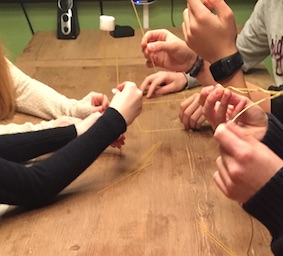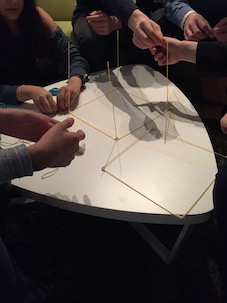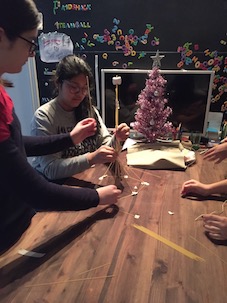Sometimes I get the opportunity to try things that I’ve never done before or didn’t think I would dare. Always take those chances if you get them! I’ve never regretted seizing those opportunities once they’re over.
In this case, I had the chance to talk with a group of school kids (ages 14-16) about Lean, experimentation, and how to iterate faster by improving processes. It was quite an experience, and I want to share some highlights from the time I spent with them.
Background
I have a friend, Tristessa, who is a teacher at an international school in Stockholm. She’s a brilliant horn player, and we play in the same band. One day during rehearsal, she told me about a Product Design course she was teaching in her class (SO COOL), and her students were facing many of the challenges I encounter at work every day—needs for experiments, a flexible process, focusing on goals rather than activities, etc.
She knows a bit about what I do and have taken an interest in, so she invited me to talk with her class about “lean, agile, and kanban stuff.” I’ve been there before talking about TDD, and it was great, so I took another chance.
We discussed a bit, and I decided to do the Marshmallow Challenge with them and then talk a bit about kanban to help them get their process under control. This post mainly covers what I learned during the marshmallow challenge exercise.
Marshmallow Challenge
The Marshmallow Challenge is a game used for team building and as a learning tool for design thinking and fostering a product mindset that focuses on learning and experimentation.
The rules seem simple (see the picture below)

There’s a catch: the marshmallow is much heavier than you’d think. So heavy, in fact, that when you put it on a spaghetti straw, the straw breaks.
This is important, and it’s why the most common result in the game is actually zero cm, lower than if you just put the marshmallow on the table flat (about 2 cm high).
What I Observed and Learned
I’ll share my observations per team, as each had a different approach and results.
Team 1 - The Experimenters
Team 1 (assigned randomly by me for clarity) entered their area, and the first thing they did was put the marshmallow on top of a spaghetti straw. Just one. Holding it. By doing this, they saw how the spaghetti straw bent and wiggled under the weight.

At that point, I told their teacher:
That team is going to win.
After about 2 minutes, they asked if they could be measured many times (Yes, of course). And 30 seconds later, they asked me to measure for the first time (32 cm).
They then called me two more times for measurements before any other team even called me once. Each time, they made a little improvement and bettered their result somewhat.
At the end of the game, I’d measured their creation 4 times and been called one extra time since they put on some nice decorations and just wanted to show me that it was pretty.
They won, with a final height of 56 cm, about 20 cm higher than the second-placing team.
The reason for their success, I think, was that they were experimenting and learning what worked based on their previous experience.
A fun thing happened at the end: one guy squashed the marshmallow and flattened it out. They then rolled it into a tiny pin and wrapped that around the straw, reaching another 8 cm higher.
Very creative thinking based on their experiences; they had time to do that and were already happy with their result.
Team 2 - The Architects
The second team took a very different approach. They decided (together) that they needed a sturdy structure to support the weight of the marshmallow and built a big, strong square of straws.

It was quite impressive to see it being built… but ultimately, it was not sturdy enough. Once (after 14 and a half minutes), they had something that they even thought would support the marshmallow, it fell over on the side.
That was such a big disappointment that they more or less gave up. It was not improved by the fact that the structure stood for a short period of time, and then I was “too slow” to measure.
Funnily, I asked them what they thought they achieved: “How high do you think it was?”. This was just to defend myself but turned out to show something else that I didn’t think of.
Their guess was about 15 cm lower than the worst result we got. They couldn’t even imagine that they could reach the heights of the others in the room.
Team 3 - The Look-over-the-Shoulders
Team 3 had a very long period of time where absolutely nothing got done. They were turning the straws over, trying out some tape, or even cracking the straws into smaller parts—without really knowing why.
After about 10 minutes, one girl just grabbed a bunch of straws, creating a tepee-kind of structure. They wrapped some tape around it and then put the marshmallow on top, laughing at their creation.

I swung by and asked if I should measure it, but they said:
No - it’s not tall enough to be measured.
It was like they thought it had some kind of minimum limit before I would measure it. I still measured it, and it was actually 31 cm, one cm lower than the first result of the team that ultimately won.
They didn’t have time to do any more experiments.
Team 4 - The Good Students
This team followed the structure for excellent school work in a group to the letter.
- They gathered ideas on paper
- They voted on which idea they liked the best
- They made a sketch
- They started to build it
After about 12 minutes, they realized that the structure would crack under the weight of the marshmallow. They scrapped the idea and just used the bottom 30% of the structure.
At this point, something amazing and heartwarming happened: in the background of the group, a kid sat very quietly. He said nothing, but as the tests of the initial idea started, he stepped forward and looked in, said “That will not work,” and then sat down again.
When the tower fell over, he stepped forward again and started to build on top of the structure that was left. He managed to build another structure on top and then showed the rest of the team how he thought it would work.
He added the marshmallow on top, and they reached 48 cm. At that time, the highest structure recorded, only to be broken by the winning team (and by merely 8 cm more).
Although he had been in the background so far, this caught his attention, and he was the one who got the team to get a result at all when the others were close to giving up.
Summary
Team 1 adopted a very agile, experiment-driven approach, which was perfect in this case where the best solution could not be known in advance. This very much resembles most interesting business situations I’ve been in—we cannot know what works best in advance. This team won and had a lot of fun in the process. This was the only team that did decorations on their tower and they showed great pride in their creation.
Team 2 represents the archetypical waterfall project. Grand and well-laid plans that they stuck to throughout the project, a big crisis in the end that they couldn’t recover from, ending up with zero results. And in fact, it even impacted what they could imagine as a good result. This team came in last with no result recorded.
Team 3 was held back by their assumptions about the task at hand. They were so nervous about making something that was not good enough that they didn’t even want to try. When they finally did try, they achieved something that was just a fraction higher than your ordinary spaghetti straw. They came in third.
Team 4 followed the process rather than following what they thought would work. But when the crisis came, they had the strength to go out of the problem, learn from it, and become something better than they initially thought they could be. They came in second with a result that for a long time was the leader.